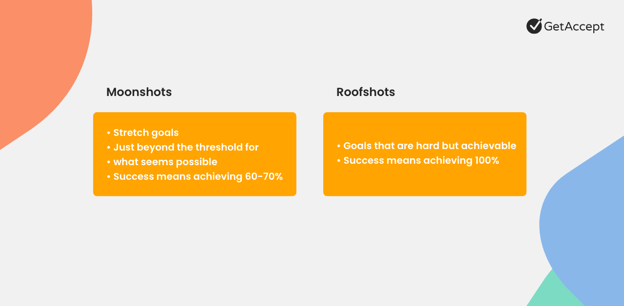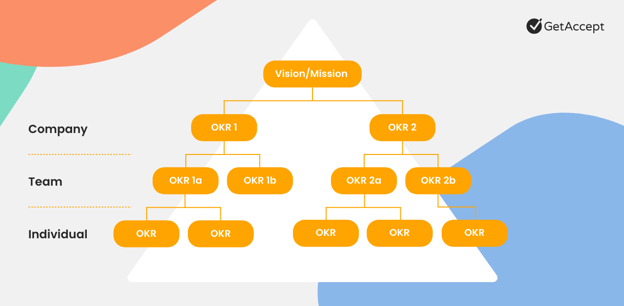The framework of OKRs [Objectives and Key Results] is often credited to Google and something Google has implemented as part of the company culture, helping them align their goals and achievements throughout the organization and grow 10x many times over.
Fun fact, however, OKRs have been around longer than that. The father of OKRs is actually a man called Andy Grove, who introduced the approach to the company Intel as early as the 70ies. John Doerr, another well-known name in OKR contexts, worked as a salesman at Intel and was introduced to the methodology of OKRs during his time there. In 1999 he, in his turn, introduced the concept to a start-up company he had invested in. Guess which start-up? Right, Google.*
Since becoming popular and widely implemented at Google, OKRs have been used at other similar tech organizations such as Amazon, LinkedIn, Spotify, and Twitter.
The purpose of working with OKRs
At GetAccept, we have been working with OKRs for over 2 years now. And we are refining and improving as we go along. Why are we using OKRs?
Growth - It’s a pain to grow and this is the treatment to make it possible
Focus - Align the team and work towards the same direction
Company & Team Transparency - Help each other to reach the goals
Engagement - Everyone is helping out to propel towards our vision
Accountability - Clarify who has the responsibility for what
In other words, the purpose is to set the overall direction on a company level and by breaking it down into graspable goals for each department/team and individual, we stay focused on the important strategic objectives of our company.
The Objectives should be:
Memorable
Challenging and Ambitious
Simple and Short
Inspiring
FUN
Objectives should be ambitious, stretched, and feel somewhat uncomfortable. However, the Inspiring and fun part is also particularly important.
The Key Results describes what needs to be done to achieve the Objectives and they should be:
Measurable
Self-explaining
2-5 per Objective
Ambitious (Moonshot vs roofshots)
It’s not a task
“If it doesn’t have a number it’s not a key result”
Typically, an organization has three to five high-level objectives and three to five key results per objective. At GetAccept we have 3 company-wide Objectives and 3-4 Key Results per each Objective. We are trying to combine the OKRs to be one moonshot and two roofshoot.

What's the difference between OKRs and KPIs one might wonder?
In other companies that I’ve been at, we have worked with KPIs to measure performance towards targets instead of OKRs. What's the difference between OKRs and KPIs one might wonder? Put it simply: they are both parts of the same picture - OKRs are a framework that helps you define your top strategic goals and identify how to achieve them, while KPIs help you measure performance against your goals. OKRs are usually a good fit for organizations heavily focused on growth.
This is how we implement OKRs to kick off the new year
Based on our strategic direction, our business goals, and of course our vision and mission statements, we have set the company OKRs for 2021 within the Management team. This has been done through a number of workshops during Q4 last year. The next step is to set the OKRs on a team level. Instead of each leader for each team deciding on the OKRs top-down, we believe it's important to do this bottom-up. Therefore we are conducting workshops in each team, in order to decide on the team OKRs together.
We ask ourselves:
What should our team Objective be, which we as a team can strive towards during the quarter or year?
It's important that the team Objective aligns with one or two of the overall company Objectives.
Once we have agreed on the team Objective, we move forward to discussing the Key Results, by asking ourselves:
What do we need to do in order to be able to reach our Objectives?
If Objective is the WHAT, the Key Results are the HOW. Remember though that Key Results need to be measurable, hence they can’t be tasks or assignments. It can be helpful to look at it as below:
We will __(Objective)__ as measured by __(Key Result)__.
Lastly, we break the team OKRs down on an individual level. This is still a work in progress for us and so far we have agreed that individual OKRs can be either quantitative or task and assignment-oriented. As long as they connect to the overall OKRs. By completing each assignment, we move closer to our strategic goals.
The principle of breaking OKRs down throughout the organization looks like this:

How we work with our OKRs
1. Once decided and anchored within the organization, and for each team, we break down the OKRs into actions. What do we need to actually do to make sure the Key Results and Objectives are met? For the Marketing team, this means connecting our Marketing plans and activities to the OKRs.
Example: If our KR is to contribute with a certain amount of revenue (ARR), we look at what demand gen activities we need to carry out, to make this happen (that drives xx MQLs, that convert into xx SQLs and paying customers = $$ ARR)
2. We follow up weekly in the teams to see how we are progressing towards the targets. We talk about the team OKRs and we highlight every team members’ individual targets and contribution to the OKRs.
3. Every month during our All Hands meeting we talk about our company wide OKRs to make sure we all have eyes on the (same) prize and move in the same direction.
4. There are several tools that can be used to gather, visualize and track OKRs throughout the company. We have just started using Winningtemp’s OKR module.
5. Every quarter we summarize and evaluate the results of our OKRs, and set new ones for the coming quarter.
We hope this can inspire you to start working with OKRs in your company too!
* John Doerr's “Measure What Matters”
.png)


